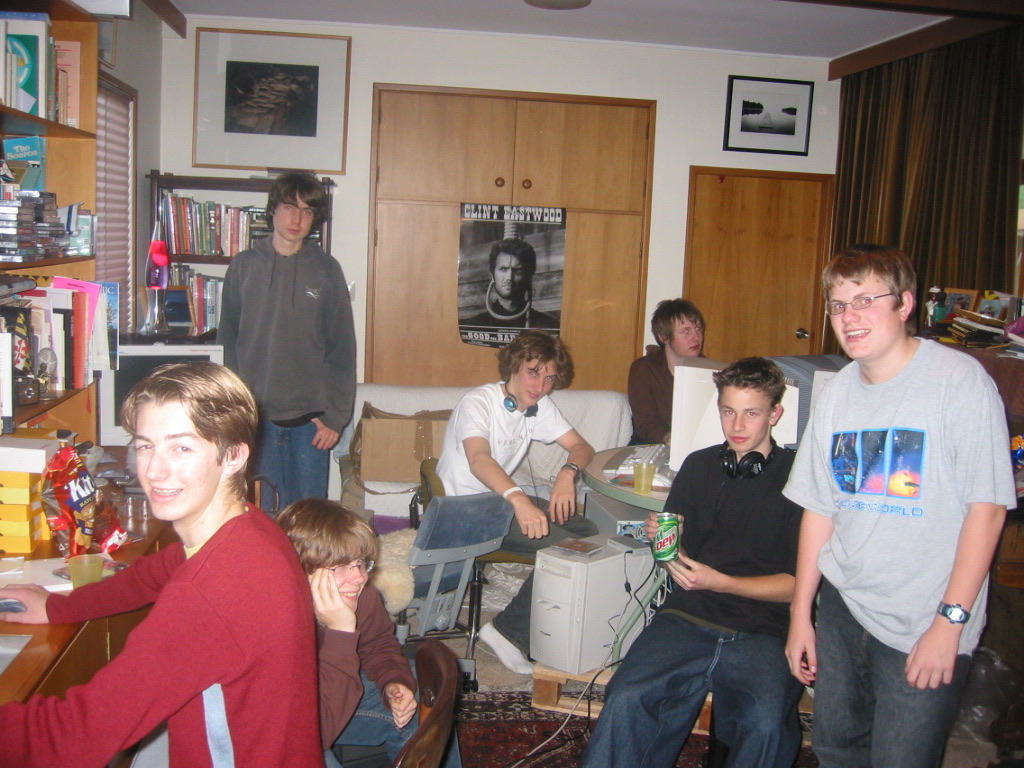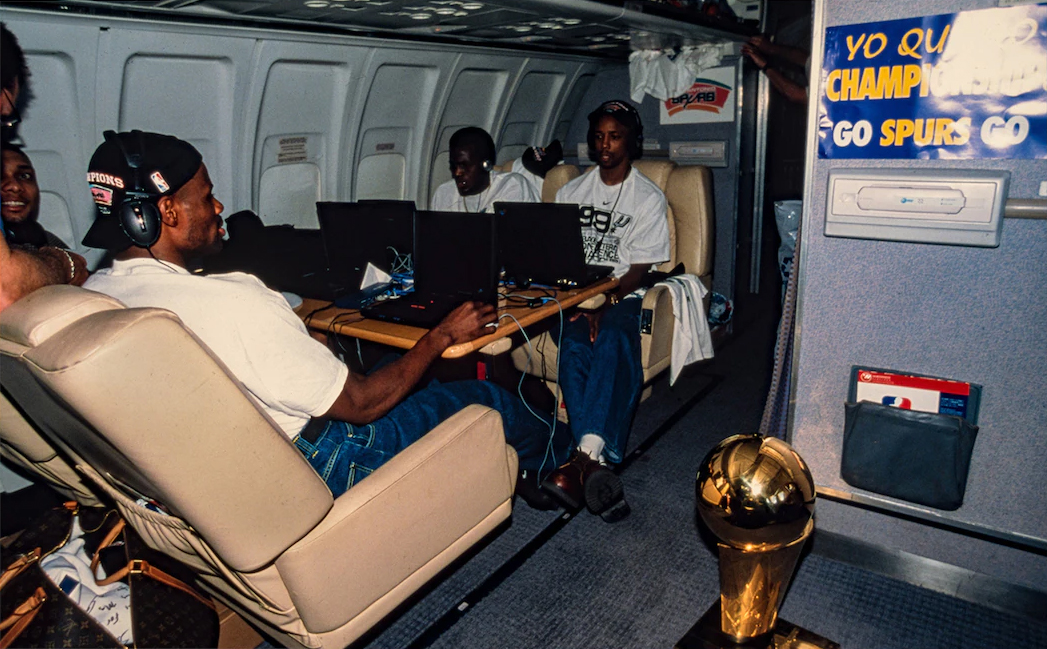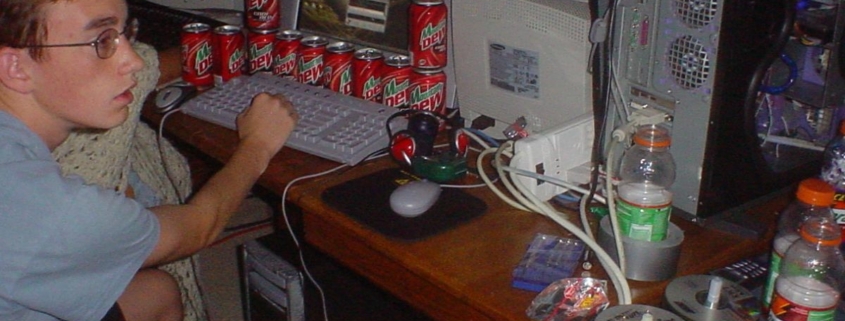These incredible LAN party photos remind us how much work it used to be to play games together

For a subset of PC gamers, happiness was a basement crammed with off-white tower PCs, interlaced extension cables, two-liter bottles of full-sugar Coca-Cola, and enough players to fill out both the Terrorist and Counter-Terrorist sides on de_dust. LAN parties represent a blip in time. The multiplayer revolution was well underway by the late 1990s—Quake and Doom had conquered college campuses, and Microsoft was preparing a new console with a built-in ethernet port—but cyberspace itself had not yet caught up to our insurgent bandwidth demands. The 100-player headcounts of Warzone and Battlefield were but a dream. The only way to circumvent that deficiency? A bunch of LAN cables and enough friends willing to schlep their machines to the makeshift arena for a big night in.
My interaction with computers today is often rote and negative. I think a lot of people in their 20s and 30s feel that way.
Merritt K
This is the subject of LAN Party (opens in new tab), an upcoming photobook from writer and game designer Merritt K (opens in new tab), which reproduces over 400 greasy snapshots of the era, specifically the years between 1997 and 2004. Flip through the book’s 176 pages and you’ll find pyramids of empty Mountain Dew cans, fat CRT monitors perched precariously on kitchen tables, and a whole inventory of regrettably X-Treme fashion decisions. It is a loving tribute to gamer putrescence.

I am 31 years old, which means the images summon up something indescribable within me: a bizarre amalgam of joy, wistfulness, melancholy, retroactive embarrassment, and, perhaps, a twinge of lost innocence. Perhaps we keep playing videogames into adulthood in order to chase down a bygone sublimity lost to our youth. I am incapable of articulating that sensation precisely, but with Merritt’s book, we can at least point to a photo of a bunch of teenagers gearing up for a marathon Diablo 2 session under the watchful eyes of a Goodfellas poster, and hope everyone else gets the idea.
“There’s an obvious element of nostalgia for people who lived through the period. But I’ve also had some people who were born later on, and were like, ‘I was born in the wrong generation,’ which is funny,” Merritt said in an interview with PC Gamer. “For me it feels celebratory. I do think, when I look back at these photos, it reminds me of a time when computers were so exciting, facilitating this new type of play between people. My interaction with computers today is often rote and negative. I think a lot of people in their 20s and 30s feel that way. So I wonder if there’s anything we can take from this period, and apply it to how we relate with computers today.”
There are amazing photos of LAN parties online, but it’s tricky to determine where they came from.
Merritt K
Merritt collected the majority of the photos in LAN Party through crowdsourcing calls. The LAN party heyday was pre-iPhone and pre-social media, and yet, a ton of grizzled gamers still held on to the glossy photographs of their decades-old Unreal Tournament matches. Those were easy to clear for the book (Merritt was in direct contact with the authors of the material for accreditation purposes) and the images themselves tend to capture the ritual of play au naturel—the unscrupulous splendor of fragging your friends on a humid summer evening. One of Merritt’s favorite photos in the collection is something like an accidental collage of turn-of-the-millennium paraphernalia.
“You can see the Windows XP background, a burnt copy of StarCraft written in sharpie, there’s a pair of over-the-back-of-the-head headphones that everyone I knew in high school owned,” she said. “It feels like it’s still life.”

Other times, Merritt set out on her own to identify the sourcing of the many mysterious, undocumented LAN party snapshots that have lived on in mildewed forums for generations. Unfortunately her one white whale remained permanently out of reach. After the San Antonio Spurs won the NBA Championship in 1999, a photo was taken of three players linking up their chunky laptops for a quick round of StarCraft on the plane ride home. The photo drips with intrigue. (My favorite element? The Larry O’Brien trophy, sitting on the floor in the bottom right corner, totally unattended.) Despite all of her efforts, Merritt couldn’t track down the person who snapped the picture. It’s one of the vestiges of the LAN party epoch. In a pre-metadata society, some archives are truly untraceable.
“I spoke to the team photographer at the time, he didn’t know who took it,” said Merritt. “There was a Washington Post article (opens in new tab) about it recently, and there wasn’t any information there either. That’s part of it. There are amazing photos of LAN parties online, but it’s tricky to determine where they came from.”
It’s been a long time since Merritt, or I, or likely you, have attended a LAN party. The tradition isn’t totally dead—I attended a QuakeCon a few years back and was stunned by the number of people who are still packing their ridiculous, neon-drenched PC cases for cross-country travel—but those events feel more like a formal consecration of our nostalgia. Like tickets to the never-ending Elton John farewell tour, they’re a self-conscious way to prove that the dream isn’t dead.
There’s a fatigue in how the internet has infiltrated every part of our lives.
Merritt K
A true LAN Party is fabricated out of necessity, and it has been a very long time since multiplayer gaming required the meeting of corporeal forms. This is the thing Merritt believes we’re missing when we pore over the sweaty, cluttered, inhospitable LAN parties of yore.
Remember when it was hard to get more than eight people in a game?
Remember how you’d wrap the cable around folding tables and recliner chairs, just so we could steal a few hours to enjoy Blood Gulch in the way it was meant to be?
Remember how annoyed you’d get when one of your pals flaked? I play Warzone with a couple of casuals every week, and I’ve never felt that same buzz when we amble into the matchmaking queue. Yes, this is a symptom of getting older, but it also has to be something else, too.
“You had to work to do it. You had to get everyone together into one place. There was a lot of hacking together technology—you’d be cramming computers into spaces where they weren’t meant to be. There was a communal aspect to that,” says Merritt. “There’s a fatigue in how the internet has infiltrated every part of our lives.”
LAN Party is still up for financial backing through December. You can pledge, and order a copy, from Volume (opens in new tab).
Source link




